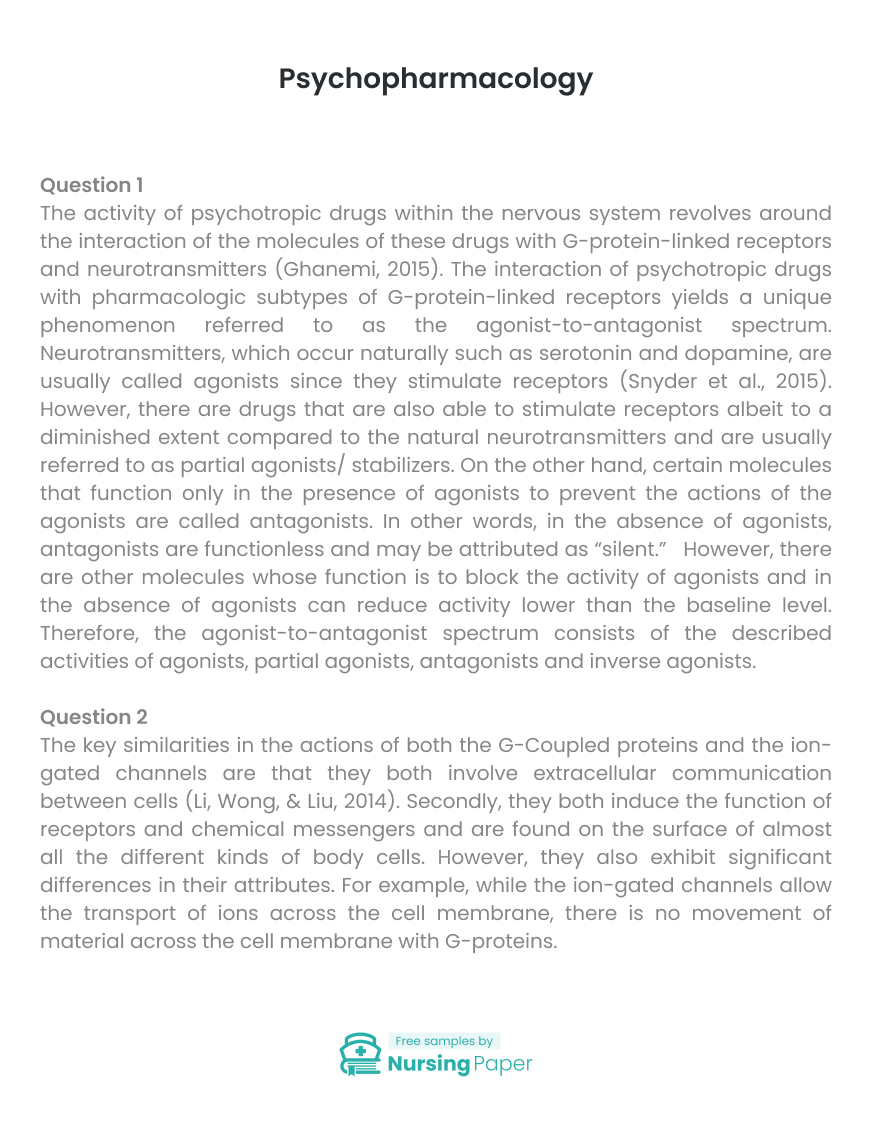
Psychopharmacology Essay
Question 1
The activity of psychotropic drugs within the nervous system revolves around the interaction of the molecules of these drugs with G-protein-linked receptors and neurotransmitters (Ghanemi, 2015). The interaction of psychotropic drugs with pharmacologic subtypes of G-protein-linked receptors yields a unique phenomenon referred to as the agonist-to-antagonist spectrum. Neurotransmitters, which occur naturally such as serotonin and dopamine, are usually called agonists since they stimulate receptors (Snyder et al., 2015). However, there are drugs that are also able to stimulate receptors albeit to a diminished extent compared to the natural neurotransmitters and are usually referred to as partial agonists/ stabilizers. On the other hand, certain molecules that function only in the presence of agonists to prevent the actions of the agonists are called antagonists. In other words, in the absence of agonists, antagonists are functionless and may be attributed as “silent.” However, there are other molecules whose function is to block the activity of agonists and in the absence of agonists can reduce activity lower than the baseline level. Therefore, the agonist-to-antagonist spectrum consists of the described activities of agonists, partial agonists, antagonists and inverse agonists.
Question 2
The key similarities in the actions of both the G-Coupled proteins and the ion-gated channels are that they both involve extracellular communication between cells (Li, Wong, & Liu, 2014). Secondly, they both induce the function of receptors and chemical messengers and are found on the surface of almost all the different kinds of body cells. However, they also exhibit significant differences in their attributes. For example, while the ion-gated channels allow the transport of ions across the cell membrane, there is no movement of material across the cell membrane with G-proteins. Furthermore, G-proteins must work with a secondary messenger, which is not the case with ion-gated channels, which do not require secondary messengers.


Question 3
Epigenetic influence of gene activity exhibits a significant contribution to the development of diseases including neurodegenerative illnesses such as Alzheimer’s disease and degenerative cellular illnesses such as cancer. The importance of epigenetics in pharmacologic action emanates from the fact that drugs can be made to counter or regulate the mechanisms of epigenetics and thus prevent or cure a disease (Stefanska, & MacEwan, 2015).
Question 4
The information on psychopharmacology delineated in this study is useful in providing useful information concerning an illness, how to manage it, and the potential side effects associated with the use of a given prescribed medication. Considering that there are possibilities that the action of a certain psychotropic drug interaction with another may inhibit the action of the second drug, it is important to ensure that competing drugs are not prescribed concurrently. For example, the use of antidementia drugs (ADDs) in patients with Alzheimer’s disease (AD) could inhibit the actions of medications targeted at AD (Hessmann et al., 2018).
1. Hessmann, P., Dodel, R., Baum, E., Müller, M. J., Paschke, G., Kis, B., … & Balzer-Geldsetzer, M. (2018). Use of antidementia drugs in German patients with Alzheimer’s disease. International clinical psychopharmacology, 33(2), 103-110.
2. Ghanemi, A. (2015). Targeting G protein coupled receptor-related pathways as emerging molecular therapies. Saudi Pharmaceutical Journal, 23(2), 115-129.
3. Snyder, G. L., Vanover, K. E., Zhu, H., Miller, D. B., O’Callaghan, J. P., Tomesch, J., … & Nestler, E. J. (2015). Functional profile of a novel modulator of serotonin, dopamine, and glutamate neurotransmission. Psychopharmacology, 232(3), 605-621.
4. Li, S., Wong, A. H., & Liu, F. (2014). Ligand-gated ion channel interacting proteins and their role in neuroprotection. Frontiers in cellular neuroscience, 8, 125.
5. Stefanska, B., & MacEwan, D. J. (2015). Epigenetics and pharmacology. British journal of pharmacology, 172(11), 2701-2704.



The download will start shortly.

The download will start shortly.
 Subject:
Health and Social Care
Subject:
Health and Social Care  Number of pages: 2
Number of pages: 2  Subject:
Nursing
Subject:
Nursing  Number of pages: 17
Number of pages: 17  Subject:
Medicine
Subject:
Medicine  Number of pages: 2
Number of pages: 2  Subject:
Health and Social Care
Subject:
Health and Social Care  Number of pages: 4
Number of pages: 4  Subject:
Health and Social Care
Subject:
Health and Social Care  Number of pages: 4
Number of pages: 4  Subject:
Medicine
Subject:
Medicine  Number of pages: 3
Number of pages: 3  Subject:
Health and Social Care
Subject:
Health and Social Care  Number of pages: 6
Number of pages: 6  Subject:
Medicine
Subject:
Medicine  Number of pages: 3
Number of pages: 3  Subject:
Health and Social Care
Subject:
Health and Social Care  Number of pages: 5
Number of pages: 5  Subject:
Health and Social Care
Subject:
Health and Social Care  Number of pages: 2
Number of pages: 2  Subject:
Health and Social Care
Subject:
Health and Social Care  Number of pages: 2
Number of pages: 2  Subject:
Medicine
Subject:
Medicine  Number of pages: 2
Number of pages: 2  Subject:
Health and Social Care
Subject:
Health and Social Care  Number of pages: 2
Number of pages: 2  Subject:
Medicine
Subject:
Medicine  Number of pages: 2
Number of pages: 2  Subject:
Health and Social Care
Subject:
Health and Social Care  Number of pages: 6
Number of pages: 6 
